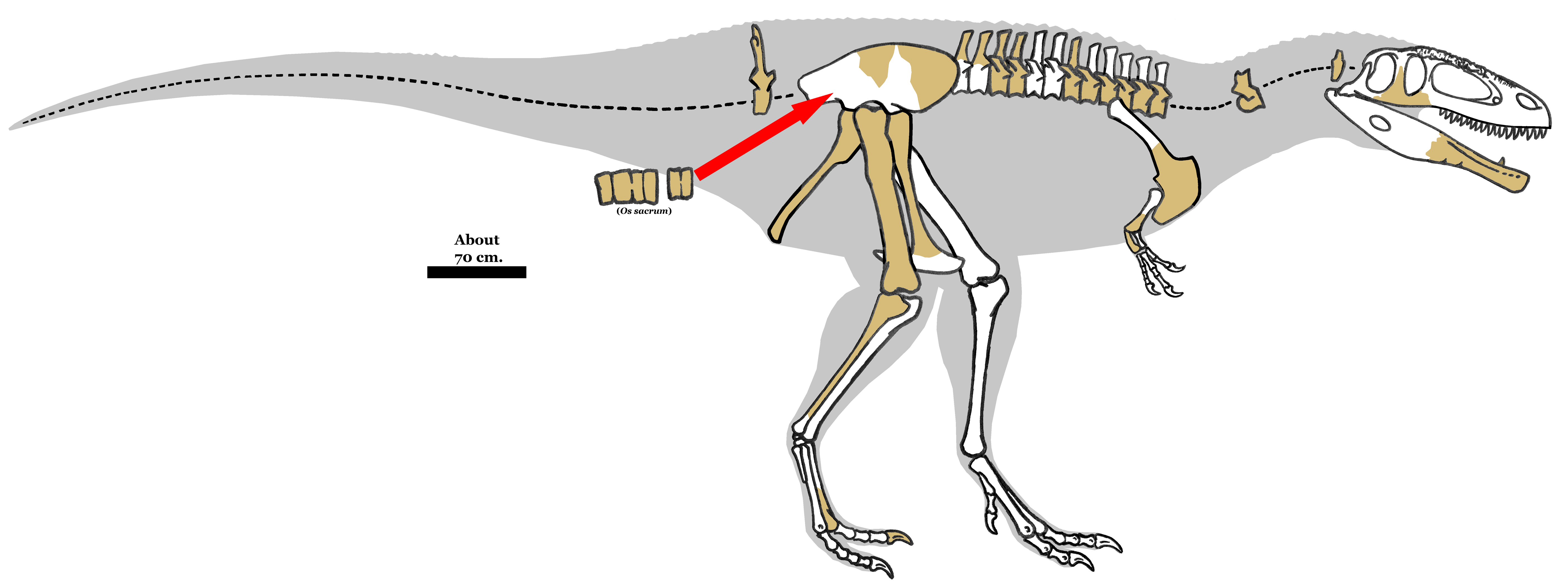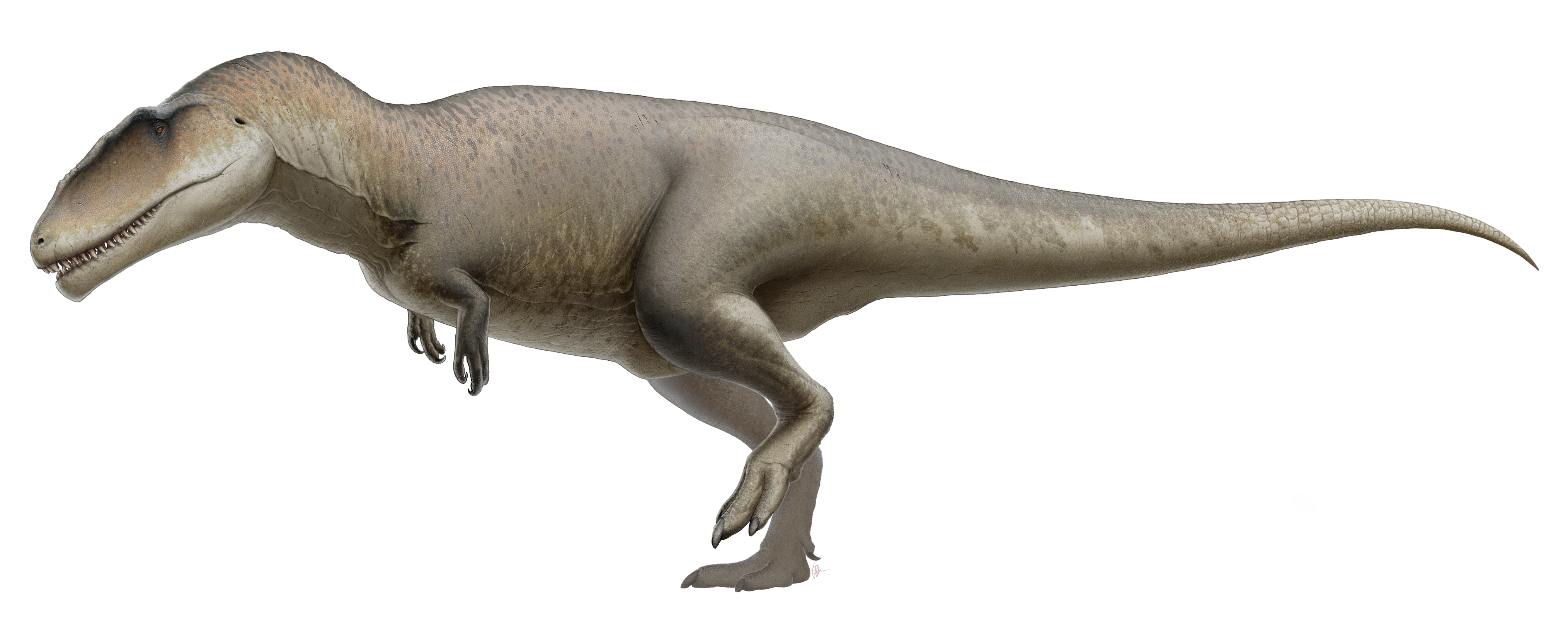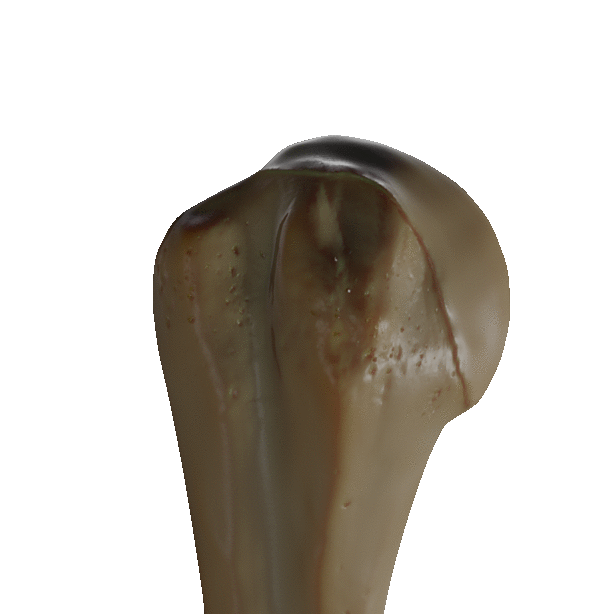|
Tyrannotitan
''Tyrannotitan'' (; ) is a genus of huge bipedal carnivorous dinosaur of the carcharodontosaurid family from the Aptian stage of the early Cretaceous period, discovered in Argentina. It is closely related to other giant predators like ''Carcharodontosaurus'' and especially ''Giganotosaurus'' as well as '' Mapusaurus''. Discovery and species ''Tyrannotitan chubutensis'' was described by Fernando E. Novas, Silvina de Valais, Pat Vickers-Rich, and Tom Rich in 2005. The fossils were found at La Juanita Farm, northeast of Paso de Indios, Chubut Province, Argentina. They are believed to have been from the Cerro Castaño Member, Cerro Barcino Formation (Aptian stage). The holotype material was designated MPEF-PV 1156 and included partial dentaries, teeth, back vertebrae 3–8 and 11–14, proximal tail vertebrae, ribs and chevrons, a fragmentary scapulocoracoid, humerus, ulna, partial ilium, a nearly complete femur, fibula, and left metatarsal 2. Additional material (designat ... [...More Info...] [...Related Items...] OR: [Wikipedia] [Google] [Baidu] |
Tyrannotitan Remains 01
''Tyrannotitan'' (; ) is a genus of huge bipedal carnivorous dinosaur of the carcharodontosaurid family from the Aptian stage of the early Cretaceous period, discovered in Argentina. It is closely related to other giant predators like ''Carcharodontosaurus'' and especially ''Giganotosaurus'' as well as ''Mapusaurus''. Discovery and species ''Tyrannotitan chubutensis'' was described by Fernando E. Novas, Silvina de Valais, Pat Vickers-Rich, and Tom Rich in 2005. The fossils were found at La Juanita Farm, northeast of Paso de Indios, Chubut Province, Argentina. They are believed to have been from the Cerro Castaño Member, Cerro Barcino Formation (Aptian stage). The holotype material was designated MPEF-PV 1156 and included partial dentaries, teeth, back vertebrae 3–8 and 11–14, proximal tail vertebrae, ribs and chevrons, a fragmentary scapulocoracoid, humerus, ulna, partial ilium, a nearly complete femur, fibula, and left metatarsal 2. Additional material (designated M ... [...More Info...] [...Related Items...] OR: [Wikipedia] [Google] [Baidu] |
Carcharodontosauridae
Carcharodontosauridae (carcharodontosaurids; from the Greek καρχαροδοντόσαυρος, ''carcharodontósauros'': "shark-toothed lizards") is a group of carnivorous theropod dinosaurs. In 1931, Ernst Stromer named Carcharodontosauridae as a family, which, in modern paleontology, indicates a clade within Carnosauria. Carcharodontosaurids include some of the largest land predators ever known: '' Giganotosaurus'', '' Mapusaurus'', '' Carcharodontosaurus'', and '' Tyrannotitan'' all rivaled or exceeded ''Tyrannosaurus'' in size. A 2015 paper by Christophe Hendrickx and colleagues gives a maximum length estimate of for the largest carcharodontosaurids, while the smallest carcharodontosaurids were estimated to have been at least long. Evolution Along with the spinosaurids, carcharodontosaurids were the largest predators in the early and middle Cretaceous throughout Gondwana, with species also present in North America (''Acrocanthosaurus''), Europe ('' Concavenator'') ... [...More Info...] [...Related Items...] OR: [Wikipedia] [Google] [Baidu] |
Giganotosaurus
''Giganotosaurus'' ( ) is a genus of theropod dinosaur that lived in what is now Argentina, during the early Cenomanian age of the Late Cretaceous period, approximately 99.6 to 95 million years ago. The holotype specimen was discovered in the Candeleros Formation of Patagonia in 1993 and is almost 70% complete. The animal was named ''Giganotosaurus carolinii'' in 1995; the genus name translates to "giant southern lizard", and the specific name honors the discoverer, Rubén D. Carolini. A dentary bone, a tooth, and some tracks, discovered before the holotype, were later assigned to this animal. The genus attracted much interest and became part of a scientific debate about the maximum sizes of theropod dinosaurs. ''Giganotosaurus'' was one of the largest known terrestrial carnivores, but the exact size has been hard to determine due to the incompleteness of the remains found so far. Estimates for the most complete specimen range from a length of , a skull in length, and a weig ... [...More Info...] [...Related Items...] OR: [Wikipedia] [Google] [Baidu] |
Cerro Barcino Formation
The Cerro Barcino Formation (also known as the Gorro Frigio Formation) is a geological formation in South America whose strata span the Early Cretaceous to the earliest Late Cretaceous. The top age for the formation has been estimated to be Cenomanian. Earlier estimates placed the formation until the Campanian. The formation was deposited in the Cañadón Asfalto Basin, a rift basin that started forming in the earliest Jurassic. Dinosaur remains are among the fossils that have been recovered from the formation. The Cerro Barcino Formation is the second-youngest unit of the Chubut Group, which also includes the older Los Adobes Formation. Both formations cover a vast area in Chubut Province, Argentina. The two formations are distinguished by geological features suggesting a distinct change in climate, from a wetter, flood plain environment in the Los Adobes to a much more arid, desert-like environment in the Cerro Barcino.Rauhut et al., 2003 The Cerro Barcino Formation is subd ... [...More Info...] [...Related Items...] OR: [Wikipedia] [Google] [Baidu] |
2005 In Paleontology
Protozoans Diatoms Plants Conifers Angiosperms Fungi Arthropoda Arachnids Insects Xiphosurans * Fossils of ''Lunataspis'', the earliest known xiphosuran, are discovered in Canada. It was not given a formal description until 2008, however. Plesiosaurs New taxa Archosauromorphs Newly named Non-Avian dinosaurs Data courtesy of George Olshevsky's dinosaur genera list. Newly named birds Newly named pterosaurs Synapsids Non-mammalian Footnotes Complete author list As science becomes more collaborative, papers with large numbers of authors are becoming more common. To prevent the deformation of the tables, these footnotes list the contributors to papers that erect new genera and have many authors. References {{DEFAULTSORT:2005 In Paleontology 2000s in paleontology Paleontology Paleontology (), also spelled palaeontology or palæontology, is the scientific study of life that existed prior to, and sometimes including, the start of the Holoce ... [...More Info...] [...Related Items...] OR: [Wikipedia] [Google] [Baidu] |
Mapusaurus
''Mapusaurus'' () was a giant carcharodontosaurid carnosaurian dinosaur from the early Late Cretaceous (early Turonian stage), approximately 93.9 to 89.6 million years ago, of what is now Argentina. Discovery ''Mapusaurus'' was excavated between 1997 and 2001, by the Argentinian-Canadian Dinosaur Project, from an exposure of the Huincul Formation ( Rio Limay Subgroup, Cenomanian) at Cañadón del Gato. It was described and named by paleontologists Rodolfo Coria and Phil Currie in 2006. The name ''Mapusaurus'' is derived from the Mapuche word ''Mapu'', meaning 'of the Land' or 'of the Earth' and the Greek ''sauros'', meaning 'lizard'. The type species, ''Mapusaurus roseae'', is named for both the rose-colored rocks, in which the fossils were found and for Rose Letwin, who sponsored the expeditions which recovered these fossils. The designated holotype for the genus and type species, ''Mapusaurus roseae'', is an isolated right nasal (MCF-PVPH-108.1, Museo Carmen Funes, Pa ... [...More Info...] [...Related Items...] OR: [Wikipedia] [Google] [Baidu] |
Carcharodontosaurus
''Carcharodontosaurus'' (; ) is a genus of large carcharodontosaurid theropod dinosaur that existed during the Cenomanian age of the Late Cretaceous in Northern Africa. The genus ''Carcharodontosaurus'' is named after the shark genus '' Carcharodon'', itself composed of the Greek (, meaning "jagged" or "sharp") and (, "teeth"), and the suffix ' ("lizard"). It is currently known to have two species: ''C. saharicus'' and ''C. iguidensis''. History of discovery In 1924, two teeth were found in the Continental intercalaire of Algeria, showing what were at the time unique characteristics. These teeth were described by Depéret and Savornin (1925) as representing a new taxon, which they named ''Megalosaurus saharicus'' and later categorized in the subgenus '' Dryptosaurus''. Some years later, paleontologist Ernst Stromer described the remains of a partial skull and skeleton from Cenomanian aged rocks in the Bahariya Formation of Egypt (Stromer, 1931); originally excavated ... [...More Info...] [...Related Items...] OR: [Wikipedia] [Google] [Baidu] |
Chevron (anatomy)
A haemal arch also known as a chevron, is a bony arch on the ventral side of a tail vertebra of a vertebrate. The canal formed by the space between the arch and the vertebral body is the haemal canal. A spinous ventral process emerging from the haemal arch is referred to as the haemal spine. Blood vessels to and from the tail run through the arch. In reptiles, the caudofemoralis longus muscle, one of the main muscles involved in locomotion, attaches to the lateral sides of the haemal arches. In 1956, Alfred Sherwood Romer hypothesized that the position of the first haemal arch was sexually dimorphic in crocodilians and dinosaurs. However, subsequent research established that the size and position of the first haemal arch was not sexually dimorphic in crocodilians and found no evidence of significant variation in tyrannosaurid dinosaurs, indicating that haemal arches could not be used to distinguish between sexes after all. Haemal arches play an important role in the taxonomy of sa ... [...More Info...] [...Related Items...] OR: [Wikipedia] [Google] [Baidu] |
Scapulocoracoid
The scapulocoracoid is the unit of the pectoral girdle that contains the coracoid and scapula. The coracoid itself is a beak-shaped bone that is commonly found in most vertebrates with a few exceptions. The scapula is commonly known as the ''shoulder blade''. The humerus is linked to the body via the scapula, and the clavicle is connected to the sternum via the scapula as well. Theria Theria (; Greek: , wild beast) is a subclass of mammals amongst the Theriiformes. Theria includes the eutherians (including the placental mammals) and the metatherians (including the marsupials) but excludes the egg-laying monotremes. C ...n mammals lack a scapulocoracoid. References * Vertebrates Comparative Anatomy, Function, Evolution by Kenneth V. Kardong. Page 325. Vertebrate anatomy {{Vertebrate anatomy-stub ... [...More Info...] [...Related Items...] OR: [Wikipedia] [Google] [Baidu] |
Humerus
The humerus (; ) is a long bone in the arm that runs from the shoulder to the elbow. It connects the scapula and the two bones of the lower arm, the radius and ulna, and consists of three sections. The humeral upper extremity consists of a rounded head, a narrow neck, and two short processes (tubercles, sometimes called tuberosities). The body is cylindrical in its upper portion, and more prismatic below. The lower extremity consists of 2 epicondyles, 2 processes (trochlea & capitulum), and 3 fossae (radial fossa, coronoid fossa, and olecranon fossa). As well as its true anatomical neck, the constriction below the greater and lesser tubercles of the humerus is referred to as its surgical neck due to its tendency to fracture, thus often becoming the focus of surgeons. Etymology The word "humerus" is derived from la, humerus, umerus meaning upper arm, shoulder, and is linguistically related to Gothic ''ams'' shoulder and Greek ''ōmos''. Structure Upper extremity The upper or pr ... [...More Info...] [...Related Items...] OR: [Wikipedia] [Google] [Baidu] |
Ulna
The ulna (''pl''. ulnae or ulnas) is a long bone found in the forearm that stretches from the elbow to the smallest finger, and when in anatomical position, is found on the medial side of the forearm. That is, the ulna is on the same side of the forearm as the little finger. It runs parallel to the radius, the other long bone in the forearm. The ulna is usually slightly longer than the radius, but the radius is thicker. Therefore, the radius is considered to be the larger of the two. Structure The ulna is a long bone found in the forearm that stretches from the elbow to the smallest finger, and when in anatomical position, is found on the medial side of the forearm. It is broader close to the elbow, and narrows as it approaches the wrist. Close to the elbow, the ulna has a bony process, the olecranon process, a hook-like structure that fits into the olecranon fossa of the humerus. This prevents hyperextension and forms a hinge joint with the trochlea of the humerus. There ... [...More Info...] [...Related Items...] OR: [Wikipedia] [Google] [Baidu] |
Vertebra
The spinal column, a defining synapomorphy shared by nearly all vertebrates, Hagfish are believed to have secondarily lost their spinal column is a moderately flexible series of vertebrae (singular vertebra), each constituting a characteristic irregular bone whose complex structure is composed primarily of bone, and secondarily of hyaline cartilage. They show variation in the proportion contributed by these two tissue types; such variations correlate on one hand with the cerebral/caudal rank (i.e., location within the backbone), and on the other with phylogenetic differences among the vertebrate taxa. The basic configuration of a vertebra varies, but the bone is its ''body'', with the central part of the body constituting the ''centrum''. The upper (closer to) and lower (further from), respectively, the cranium and its central nervous system surfaces of the vertebra body support attachment to the intervertebral discs. The posterior part of a vertebra forms a vertebral ... [...More Info...] [...Related Items...] OR: [Wikipedia] [Google] [Baidu] |







